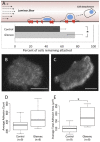Gleevec, an Abl family inhibitor, produces a profound change in cell shape and migration
- PMID: 23300967
- PMCID: PMC3534684
- DOI: 10.1371/journal.pone.0052233
Gleevec, an Abl family inhibitor, produces a profound change in cell shape and migration
Abstract
The issue of how contractility and adhesion are related to cell shape and migration pattern remains largely unresolved. In this paper we report that Gleevec (Imatinib), an Abl family kinase inhibitor, produces a profound change in the shape and migration of rat bladder tumor cells (NBTII) plated on collagen-coated substrates. Cells treated with Gleevec adopt a highly spread D-shape and migrate more rapidly with greater persistence. Accompanying this more spread state is an increase in integrin-mediated adhesion coupled with increases in the size and number of discrete adhesions. In addition, both total internal reflection fluorescence microscopy (TIRFM) and interference reflection microscopy (IRM) revealed a band of small punctate adhesions with rapid turnover near the cell leading margin. These changes led to an increase in global cell-substrate adhesion strength, as assessed by laminar flow experiments. Gleevec-treated cells have greater RhoA activity which, via myosin activation, led to an increase in the magnitude of total traction force applied to the substrate. These chemical and physical alterations upon Gleevec treatment produce the dramatic change in morphology and migration that is observed.
Conflict of interest statement
Figures









References
-
- Ridley AJ, Schwartz MA, Burridge K, Firtel RA, Ginsberg MH, et al. (2003) Cell migration: integrating signals from front to back. Science 302: 1704–1709. - PubMed
-
- Webb DJ, Zhang H, Horwitz AF (2005) Cell migration: an overview. Methods Mol Biol 294: 3–11. - PubMed
-
- Franz CM, Jones GE, Ridley AJ (2002) Cell migration in development and disease. Dev Cell 2: 153–158. - PubMed
-
- Schwartzberg PL, Stall AM, Hardin JD, Bowdish KS, Humaran T, et al. (1991) Mice homozygous for the ablm1 mutation show poor viability and depletion of selected B and T cell populations. Cell 65: 1165–1175. - PubMed
-
- Li B, Boast S, de los Santos K, Schieren I, Quiroz M, et al. (2000) Mice deficient in Abl are osteoporotic and have defects in osteoblast maturation. Nat Genet 24: 304–308. - PubMed
Publication types
MeSH terms
Substances
Grants and funding
LinkOut - more resources
Full Text Sources
Other Literature Sources
Medical
Miscellaneous

